Technical
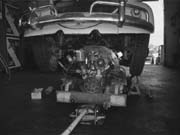
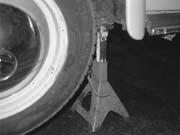
Raise the vehicle on the jackstands, placing the 4x4s in front of the
front tires. You don't have to have it up particularly high at this point,
just so you can work under it.
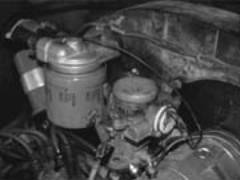
Remove the air cleaner on the engine, clean it out and add new oil. Set it
aside. Cover the top of the carburetor to prevent dirt or small parts from
falling in, a gallon-water bottle cap works well.
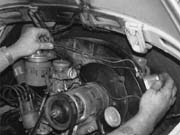
Disconnect the battery cable before going any further. It would be a good
time to clean the connections while you're under there and invest in a
pair of post pads to keep the connections from corroding. Now you can
disconnect the electrical wires to the engine. One wire connects to the
coil and one connects to the choke actuator. The rest are connected to the
generator, alternator and voltage regulator, depending on your car's year.
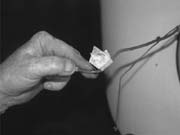
The best advice is to wrap a small piece of tape around each wire and make
a mark to indicate where it goes. Then tape the wires to the fender, out
of the way. Disconnect the accelerator cable and push the end of the cable
back through the opening in the shroud and reach around to pull the cable
through the rest of the way.
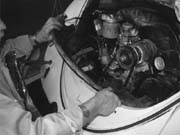
Remove the rear engine compartment tin with a big flat screwdriver. First
remove the fresh-air heater hoses (if you've got them). If they are in bad
shape--and they usually are--get a new set. Next, remove the small tin
shroud around the crankshaft pulley and the two even smaller ones around
the manifold heat risers. Then remove the main piece of the rear shroud
(shown). It should just lift out.
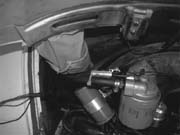
Remove the upper engine bolts/nuts. These are large 17mm bolts that
connect the engine to the transmission. On the passenger side, one of
these bolts also serves as on of the starter mounts; they are nearly
impossible to see as they are located behind the engine and out of sight.
Use a box- or open-end wrench to get to them. Be patient and get as
comfortable as you can, as you will have to reach back there and be
prepared to turn them little by little.
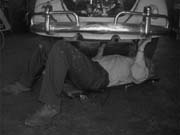
Collect together your 17mm wrench, an old pencil to plot the fuel line, a
10mm wrench, a large screwdriver and a pair of pliers. Get under the car
and verify that the jackstands are still safely supporting the car.
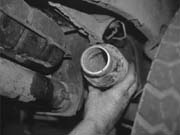
Disconnect the bellows from the heater boxes; they should just slip off.
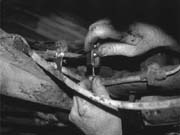
Disconnect the heater control cables. Use a 10mm wrench and pliers to hold
the attachment still while you unscrew it. Disconnect the fuel line and
stuff the old pencil into the end of the line.
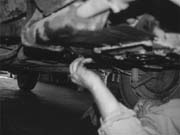
Remove the lower engine nuts with the 17mm wrench. Don't worry, the engine
will not fall on you because of the threaded studs and the input shaft.
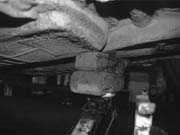
Place the 1x6 on top of the jack and put the jack under the engine,
centered on the oil drain plate. Raise the engine about an inch, just
enough to remove the pressure from the studs and input shaft. Place one
hand on the fan shroud and the other on the muffler. Now, slowly pull the
jack and the engine back toward you. This will pull the engine lose from
the lower tranny mounts.
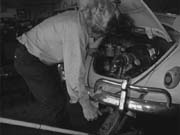
Slowly lower the jack and the engine to the ground. Make sure the studs
and input shaft don't hang up on anything on the way down.
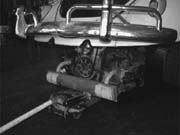
Now, raise the car higher so it can clear the engine that needs to be
pulled out from under it.
Engine Removal
Story by D.E. Meyer
Many things
can lead tothe necessity of having to remove the engine from a VW, for
example, driving around without the fan belt can hasten the inevitable. A
bad clutch could do it too, eventually. Certain oil leaks can also create
enough irritation to lead to problems. However, there also are several
good reasons to remove the engine just for R&R. No, that's not rest
and relaxation; it's removal and replacement. When you can't put it off
any longer, plan to make the best of it. Sure, it'll take a little time
and yes, you will get dirty and greasy, but this R&R will result in
many miles of trouble-free driving pleasure.
* A clean
car.
If it runs,
it would behoove you to drive it through the car wash and use a couple of
dollars' worth of quarters to clean the engine area. Be sure to clean
under the car between the engine and the transmission where it gets the
dirtiest.
*
Workspace.
Of course,
a nice garage would be best, but any cement floor will do. You could do
all of this in the dirt if you had to, but I wouldn't recommend it. For
one thing, it's just too easy to lose little parts, not to mention how
could you possibly keep things clean when you're working in dirt?
* Wood.
Find a
couple of 4x4s and 2x4s, 12 to 16 inches long and a 1x6 about 12 inches
long. You'll use the 1x6 between the jack and the engine and you'll use
the two 4x4s to block the tires to keep the car from rolling away while
you're trying to work on it.
The others
will be used between the jack and the car in a couple of places.
* Rags and
some hard cleaner.
My personal
favorite are some old t-shirts and some heavy-duty hand cleaner. The idea
is to keep the car and you clean!
* Tools.
If you
don't have at least a small toolbox with an assortment of metric wrenches,
some screwdrivers, a pair of pliers and an adjustable-end wrench, take
this article to a friend